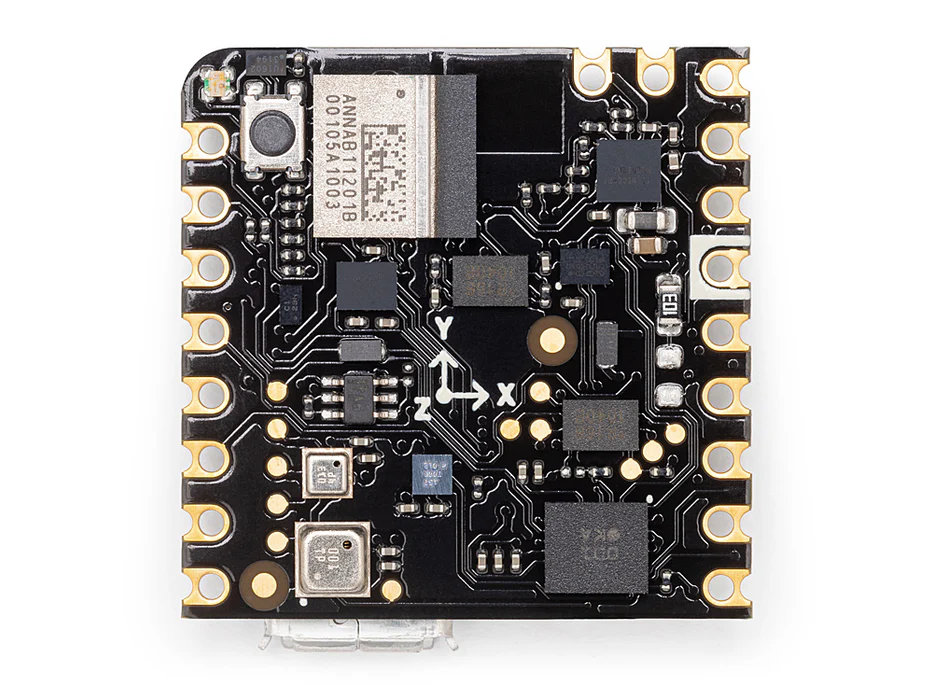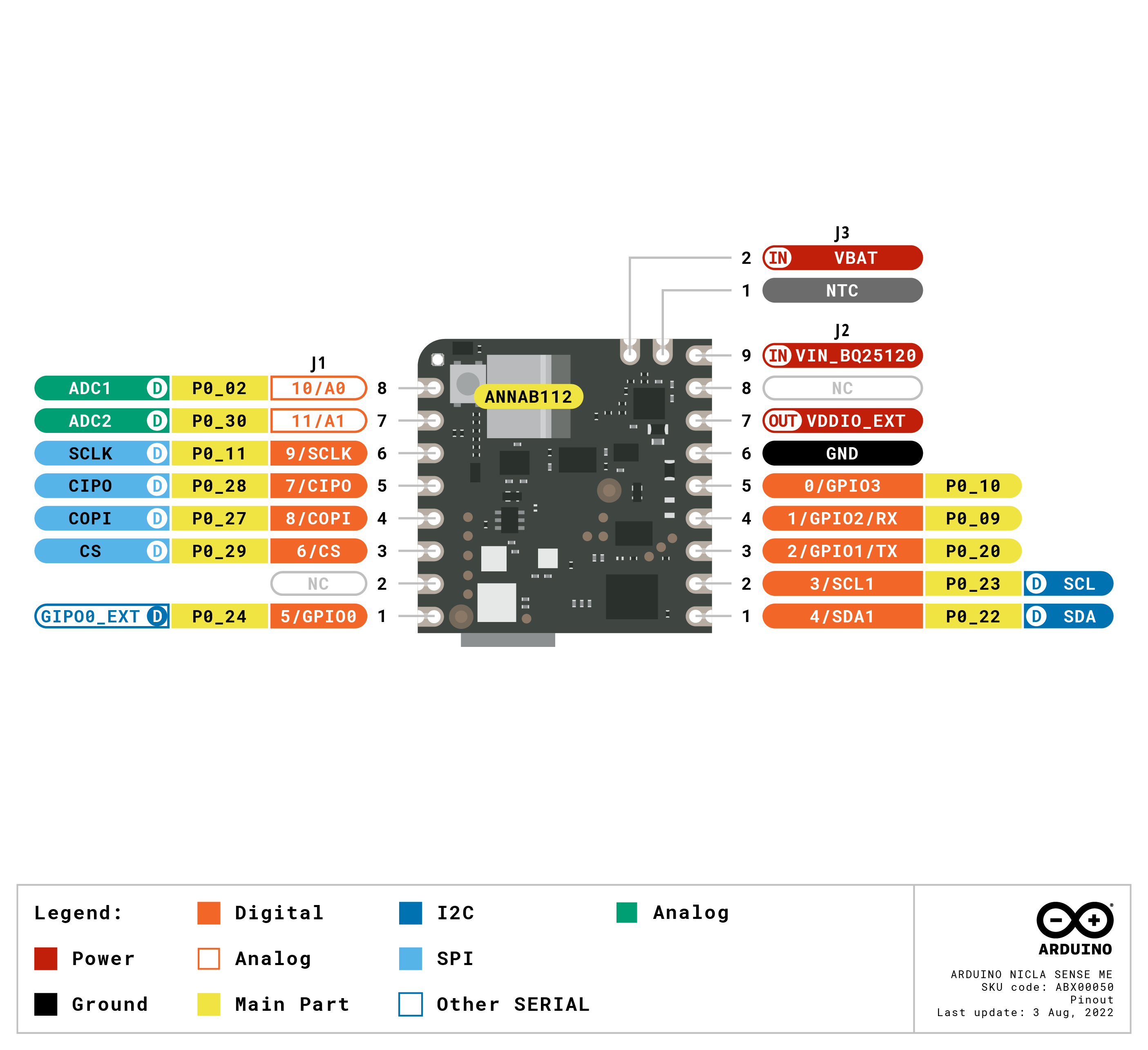
Nicla Sense ME
Bring smart sensing solutions to the edge, with the high-performance, low-power board that packs state-of-the-art Bosch Sensortec technology into our smallest form factor yet.
Overview
The Nicla Sense ME is a tiny, low-power tool that sets a new standard for intelligent sensing solutions. With the simplicity of integration and scalability of the Arduino ecosystem, the board combines four state-of-the-art sensors from Bosch Sensortec:
- BHI260AP motion sensor system with integrated AI
- BMM150 magnetometer
- BMP390 pressure sensor
- BME688 4-in-1 gas sensor with AI and integrated high-linearity, as well as high-accuracy pressure, humidity and temperature sensors.
Designed to easily analyze motion and the surrounding environment – hence the “M” and “E” in the name – it measures rotation, acceleration, pressure, humidity, temperature, air quality and CO2 levels by introducing completely new Bosch Sensortec sensors on the market.
Its tiny size and robust design make it suitable for projects that need to combine sensor fusion and AI capabilities on the edge, thanks to a strong computational power and low-consumption combination that can even lead to standalone applications when battery operated.
Part of Arduino Pro’s new Nicla family of modular, intelligent products that are easy to use, cost effective, versatile and accessible, the Sense ME has a new, tiny form factor that is also compatible with the Arduino MKR and Portenta ranges.
Key benefits
- Tiny size, packed with features
- Low power consumption
- Add sensing capabilities to existing projects
- When battery-powered, becomes a complete standalone board
- Powerful processor, capable of hosting intelligence on the Edge
- Measures motion and environmental parameters
- Robust hardware including industrial-grade sensors with embedded AI
- BLE connectivity maximizes compatibility with professional and consumer equipment
- 24/7 always-on sensor data processing at ultra-low power consumption
Need Help?
Check the Arduino Forum for questions about the Arduino Language, or how to make your own Projects with Arduino. If you need any help with your board, please get in touch with the official Arduino User Support as explained in our Contact Us page.
Warranty
You can find your board warranty information here.
Tech specs
|
Microcontroller |
64 MHz Arm® Cortex M4 (nRF52832) |
|
Sensors |
BHI260AP - Self-learning AI smart sensor with integrated accelerometer and gyroscope, BMP390 - Digital pressure sensor, BMM150 - Geomagnetic sensor, BME688 - Digital low power gas, pressure, temperature & humidity sensor with AI |
|
I/O |
Castellated pins with the following features: 1x I2C bus (with ext. ESLOV connector), 1x serial port, 1x SPI, 2x ADC , programmable I/O voltage from 1.8-3.3V |
|
Connectivity |
Bluetooth® 4.2 |
|
Power |
Micro USB (USB-B), Pin Header, 3.7V Li-po battery with Integrated battery charger |
|
Memory |
512KB Flash / 64KB RAM, 2MB SPI Flash for storage, 2MB QSPI dedicated for BHI260AP |
|
Interface |
USB interface with debug functionality |
|
Dimensions |
22,86 mm x 22,86 mm |
|
Weight |
2 g |
Conformities
Resources for Safety and Products
Manufacturer Information
The production information includes the address and related details of the product manufacturer.
Arduino S.r.l.
Via Andrea Appiani, 25
Monza, MB, IT, 20900
https://www.arduino.cc/
Responsible Person in the EU
An EU-based economic operator who ensures the product's compliance with the required regulations.
Arduino S.r.l.
Via Andrea Appiani, 25
Monza, MB, IT, 20900
Phone: +39 0113157477
Email: support@arduino.cc
Documentation
Learn more
Get Inspired

Makers have long asked the question “why bother with an expensive PLC when I can just use an Arduino?” The answer comes down to the priorities and needs of industrial clients. In a factory automation setting, the client will prioritize durability, reliability, and serviceability over the one-time purchase price of the device itself. But to prove that Arduino’s professional turnkey solutions are just as easy to use as their developer-focused educational counterparts, Jeremy Cook leveraged an Arduino Opta micro PLC to build a drum machine. This isn’t any old drum machine that plays sound samples or synthesized notes, but rather a robotic drum machine that makes noise by banging on stuff like a true percussion instrument. Cook could have built this with any Arduino board and a few relays, but instead chose to implement the Opta and new Opta Digital Expansion. That is robust enough for serious commercial and industrial applications, but is still simple to program with the familiar Arduino IDE. Programmers can also use conventional PLC languages if they prefer. In this case, Cook made noise with relays and solenoids. The Opta has four built-in relays and Cook’s sketch flips one of them to make a sound analogous to a hi-hat. Cook added an Arduino Pro Opta Ext D1608S module with its solid-state relays for the other two “drums.” One of those fires a solenoid that taps a small hand drum (the kick drum sound), while the other controls a solenoid that hits a power supply enclosure (the snare sound). Together, those three sounds can cover the basics of a drum track. Cook’s sketch is a drum sequencer program that stores each sound sequence as array, looping through them until turned off. An Opta may be overkill for a project like this one, but this does a great job of demonstrating the ease at which an Arduino user can transition to professional PLC work.










